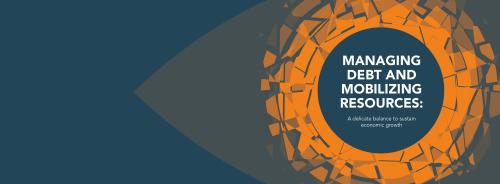Below is a viewpoint from Chapter 2 of the Foresight Africa 2019 report, which explores six overarching themes on the triumphs of the past years as well as strategies to tackle the remaining obstacles for Africa. Read the full chapter on managing debt and mobilizing resources.
Côte d’Ivoire’s objective is to reach the status of an emerging country by 2020, a goal that will require a debt management strategy that enhances economic performance over the coming years while preserving macroeconomic stability. While debt issuance is necessary to help finance capital expenditure and the broader economic agenda, the government is intent on controlling the costs and risks of debt as well as minimizing reliance on external financing by strengthening capacity for domestic resource mobilization.
In 2019 and through 2023, the government plans to mobilize new external financing, prioritizing concessional and semi-concessional sources and only considering commercial loans as a last resort. With the normalization of monetary policy in the advanced economies, notably the United States and, to a lesser extent, Europe, we expect funding conditions on international capital markets to tighten and the cost of external debt for Côte d’Ivoire to rise. Accordingly, the government will continue to favor Treasury bond issuances in the regional market where the outlook for funding conditions is more favorable. However, the regional bond market is not well developed, limiting funding from this source. Potential additional sources include local-currency denominated eurobonds and Global Depository Notes.
Côte d’Ivoire’s approach to debt management is consistent with the Guidelines for Public Debt Management published by the World Bank and the International Monetary Fund, which includes, importantly, the need for coordination among relevant branches of the government. To this effect, the government set up a National Public Debt Committee (NPDC)—an inter-ministerial committee chaired by the Minister of Finance—as a coordinating entity to ensure consistency of public debt policy with fiscal and monetary policies.
The NPDC ensures, among other things, that the level of debt is compatible with that of tax revenues, that the increase in the stock of debt is sustainable, and that the dynamics of export earnings are strong enough to support foreign currency-denominated debt. Finally, the NPDC takes the necessary steps to ensure that all public debt indicators meet set standards including remaining below debt sustainability thresholds.
The government is intent on controlling the costs and risks of debt as well as minimizing reliance on external financing.
To further ensure that the overall debt strategy is consistent with macroeconomic stability, the NPDC draws on the government’s medium-term (five years) debt management strategy (MTDS) set up since 2012. Annual adjustments to the MTDS require governmental approval to consider the medium-term macroeconomic and fiscal framework, financing needs, financial market conditions, and other relevant factors. The MTDS is subject to a debt sustainability analysis that indicates that the risk of debt distress in Côte d’Ivoire is moderate.
Even so, Côte d’Ivoire continues to implement budget reforms, enhance tax revenue collection, and improve the business environment—the country is among the top-10 improvers in the most recent Doing Business report of the World Bank. The government has also implemented additional measures to reduce procurement deadlines, to promote good governance and eradicate corruption, to boost the competitiveness of the economy, and to manage risks in public-private partnerships, among others.
With respect to public debt management, Côte d’Ivoire has favored financing that helps reduce rollover risks of domestic debt as well as currency risk of external debt. For example, new issuances of external debt will prioritize those denominated in euro, given the peg of the local currency to the euro, and new dollar-denominated debt will be hedged against exchange rate risks through euro-U.S. dollar swaps.
The government is also alert to the risks of debt accrued by public enterprises and other public sector entities. A centralized and comprehensive debt database has been set up to facilitate the monitoring of public enterprise debt and to ensure that these debts are taken into account in the national debt strategy.
At the institutional level, the government continues to bolster the capacity of the Public Debt Department and the capacity for tax revenue collection.
These strategies have allowed Côte d’Ivoire to maintain a sustainable debt level (47 percent of GDP), to finance its economic agenda, and achieve a robust economic growth rate averaging 8.7 percent over the past seven years.





Commentary
Debt management in a challenging environment: Lessons from Côte d’Ivoire
February 13, 2019